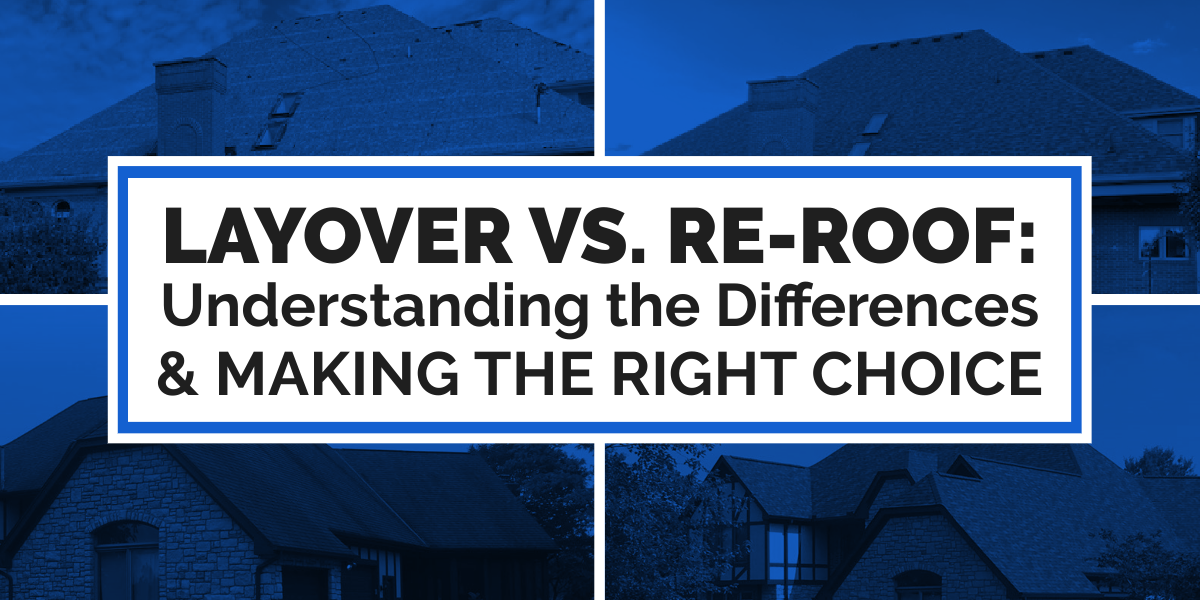A durable and well-maintained roof is essential for the protection and longevity of any home. However, there may come a time when your roof starts showing signs of wear and tear, leaving you to decide whether to do a layover (sometimes called a re-shingle) or a re-roof. Both options have their considerations, so let’s understand the differences and make the right choice for your home.
Layover: What is it?
In roofing, a layover (re-shingle) is a process where new shingles are installed over the existing ones to give your roof a fresh look. People sometimes choose this option because they do not want the extra bother or cost of tearing off old roofing shingles and roofing materials before they install new ones.
Perceived Advantages of Layovers
- Cost-effective: A layover appears more affordable than a complete re-roofing project since it doesn’t require the removal of the existing roof.
- Saves time: A layover is usually quicker to complete compared to re-roofing as it doesn’t involve tearing off the old roof.
- Enhanced aesthetics: By choosing new shingles, you can update the appearance of your home.
Considerations for Layovers
- Underlying issues: Layovers do not address underlying problems such as rotting sheathing or damaged rafters. It is vital to ensure the roof’s underlying structure is in good condition before opting for a re-shingle.
- Add-on weight: Adding a new layer of shingles increases the weight on the roof. Each layer of shingles adds weight to the roof structure. Installing a new layer over existing ones can stress the roof framing more, potentially exceeding its intended load-bearing capacity. This can lead to structural issues and compromise your home’s overall stability and safety. It is essential to consult with a roofing professional to ensure that the existing structure can support the additional weight.
- Visible imperfections: Re-shingling over an existing layer of shingles will often result in imperfections that could be visible. It may appear that your roof has a “wavy” appearance. Adding multiple layers of shingles can affect the overall aesthetic appeal of your roof. The roof may look thicker and bulkier, which may not match the original design of your home.
- Trapped moisture: When shingles are overlaid, moisture can become trapped between layers, leading to mold, mildew, and rot. The moisture can penetrate the underlying shingles, causing them to deteriorate faster. This can result in premature roof failure and the need for costly repairs or replacements.
- Void warranty: Adding another layer of shingles to your roof on top of others may void the product warranty, and most contractors cannot guarantee their workmanship if they cannot see the roof decking (sheathing).
- Difficulty in future repairs: If repairs are needed in the future, such as fixing a leak or replacing damaged shingles, it can be more challenging and time-consuming to address these issues when multiple layers of shingles are in place. This may require removing several layers of shingles, resulting in increased labor and costs.
Re-roof: Comprehensive Roof Restoration
Re-roofing involves removing the existing roofing materials and installing new underlayment and shingles. This option is ideal for all roofs.
Advantages of Re-roofing

- Addressing underlying structural issues: Re-roofing provides an opportunity to inspect and address underlying structural problems, such as rotting sheathing, damaged flashing, or damaged rafters.
- Improves energy efficiency: Re-roofing allows for the installation of modern insulation materials, improving energy efficiency and reducing heating and cooling costs.
- Choice of roofing material: Re-roofing gives you the flexibility to choose a different roofing material or style to suit your aesthetic preferences and improve the overall value of your home.
- Full Warranty availability: Installing new roofing materials over a thoroughly inspected decking system will ensure that your product and workmanship warranties will be honored.
- Peace of mind: Knowing that your home has a new and durable roof provides peace of mind. It eliminates the constant worry about leaks during heavy rainstorms or potential damage during harsh weather conditions. Re-roofing allows you to feel confident that your home is well-protected, regardless of what nature throws at it.
Considerations for Re-roofing
- Higher cost: Since re-roofing involves complete removal and replacement, it is generally a little more expensive than a layover. This extra cost is incurred by the extra labor for the removal of the old roofing material and dumpster and removal fees.
- Longer installation time: Re-roofing is slightly more time-consuming as it requires the removal of the old roof before installing the new one. On most homes, it will increase the time by about half a day to one full day. Discuss this with your roofing contractor to confirm how long it will take.
Making the Right Choice

To make an informed decision between a layover or re-roofing, consider the current condition of your roof, your budget, and your long-term plans for the home. Re-roofing your home is essential for maintaining its integrity, energy efficiency, and aesthetic appeal. It offers protection, cost savings, and peace of mind, making it a crucial investment in the longevity and value of your property.
To ensure a successful and satisfactory outcome, it is recommended to consult with a professional roofing contractor who can assess your specific situation and provide expert guidance on the most suitable option for your home. Remember, investing in the proper maintenance and care of your roof is crucial to protect the value and integrity of your property in the long run.
At Titan Roofing and Siding, we strive for the highest quality roofs for our customers. While we do not offer layovers, we offer top-notch quality and affordable roofing options in the Greater Cincinnati area. Contact us today for a free estimate!






